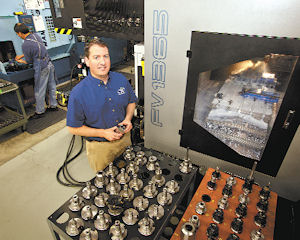After the long-awaited Federal Aviation Administration certification of the Boeing 787 Dreamliner, local suppliers to the commercial aviation industry are happy to answer the call for more parts. Even as defense spending declines, Valley companies are benefiting from a surge of orders from the commercial side of the business. “Once that (787) gets into full production we are optimistic we will see the commercial business pick up,” said Spencer Strull, business development manager at Air Electro, Inc., an electrical connector manufacturer and distributor in Chatsworth. The aerospace manufacturing base in Southern California has shrunk in the past two decades. Large aircraft makers, such as Lockheed Martin, left the area, leaving mostly small-to medium-sized aerospace businesses in the San Fernando Valley region. Many of these businesses are family-owned and got off the ground during the boom years of aerospace from the 1950s into the 1970s. Strull’s grandfather, William, started Air Electro in the 1950s. In Burbank, David Fisher took over S&H Machine from his father. Steve Cormier works with his son at Global Aerospace Technology Corp., the company he co-owns in Chatsworth. These companies and others like them are preparing for the increased work as Boeing and Airbus, the two companies that primarily build the world’s commercial jet fleet, build new aircraft. “We are definitely seeing a rebound in the business jet work and commercial aviation is coming back,” Fisher said. “We are predicting the military side will fall off. That is okay as long as the commercial side comes up to make up for that.” Concerns over a drop in military work are justified by the news coming out of Washington. The Pentagon faces $350 billion in budget cuts in the new federal budget, a move that is likely to impact aircraft manufacturers and trickle down the supply chain. A second phase of cuts that could come later this year would reduce defense spending by an additional $600 billion. The outlook for the commercial aviation market, however, is brighter. An industry forecast from Boeing anticipates that it and other commercial jet manufacturers will deliver 33,500 aircraft over the next 20 years. Single aisle jets will make up 70 percent of that number, according to a report released this year by the company. New entrants into the single aisle jet market from China, Russia and Canada may mean competition for Boeing and Airbus, but they also represent potential new business for local companies, including those in the Valley area. Other contenders, including Embraer, may be looking to get into the single-aisle market. “Unless Embraer is happy with its position in the ailing regional market and the military markets, it may look to this territory too,” concluded a report from Flightglobal, a British aerospace and aviation industry news and data website. Flightglobal forecasts strong growth in the widebody market. That fleet includes the 787 and the Airbus A350. S&H has made development parts for those aircraft, and Fisher hopes will bring future contracts. “New aircraft are going to have a cycle of 20 years to 25 years and you want to be in on that,” Fisher said. Suppliers to the 787 paid a price for the delay in the FAA certification of the aircraft. Production of parts is done on their own dime, and only later does payment come from their customer. Air Electro tooled up in anticipation of 787 orders from its customers that never came, leaving the company with more inventory than it would have liked, Strull said. It is not only new parts that bring in business to Valley manufacturers. The spare parts business keeps the doors open at Global Aerospace and Frazier Aviation in the City of San Fernando. After a rough couple of years, Global turned itself into a streamlined operation with less debt and a focus on going after work on new aircraft, Cormier said. The company has steady work supplying spare parts to aircraft owners it had not supplied before. Still, new commercial work would put Global in a better place, Cormier said. “Quick delivery and high quality gives the domestic companies a niche,” he added. “As long as your prices are reasonable, we can compete nicely against foreign competition.” Frazier Aviation Inc. had supplied commercial aircraft makers before transitioning to primarily military aircraft after the defense build-up following the Sept. 11, 2001 terrorist attacks, said President Bob Frazier. If it goes after commercial work, the company will likely stick with Boeing as it has provided parts to the company in the past. Boeing, however, does not give out single contracts and suppliers need to bid on multiple ones, Frazier said. “We have not been able to accumulate too many of those yet,” Frazier said.
